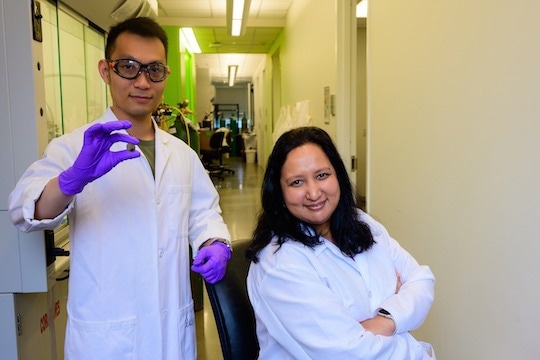Energy storage capacity might be revolutionized by silicon anode batteries, which is essential for achieving climate targets and realizing the full potential of electric vehicles.
 Quan Nguyen (left), Sibani Lisa Biswal and collaborators developed a prelithiation technique that helps improve the performance of lithium-ion batteries with silicon anodes. Image Credit: Jeff Fitlow/Rice University
Quan Nguyen (left), Sibani Lisa Biswal and collaborators developed a prelithiation technique that helps improve the performance of lithium-ion batteries with silicon anodes. Image Credit: Jeff Fitlow/Rice University
The production of next-generation lithium-ion batteries is severely hampered by the irreversible lithium-ion depletion in silicon anodes.
Researchers at Rice University’s George R. Brown School of Engineering have created a scalable way to enhance prelithiation, a procedure that coats silicon anodes with stabilized lithium metal particles (SLMPs) to reduce lithium loss and lengthen battery life cycles.
Battery life is increased by 22% to 44% when the anodes are sprayed with a combination of the particles and a surfactant, according to research from Rice University’s Sibani Lisa Biswal’s group of chemical and biomolecular engineers. Higher levels of the coating originally led to battery cells with increased stability and cycle life.
The disadvantage was that the battery faded quicker in subsequent cycles when cycled at full capacity since more of the particle coating resulted in more lithium trapping.
ACS Applied Energy Materials published the study.
Since graphite, which is comprised of carbon, can pack fewer lithium ions than silicon, replacing it in lithium-ion batteries would greatly enhance their energy density (the amount of energy stored compared to weight and size). Each lithium-ion requires six carbon atoms, whereas one silicon atom can link with up to four lithium ions.
Silicon is one of those materials that has the capability to really improve the energy density for the anode side of lithium-ion batteries. That is why there is currently this push in battery science to replace graphite anodes with silicon ones.
Sibani Lisa Biswal, Professor, Materials Science and NanoEngineering, Rice University
However, silicon has additional qualities that make it difficult to work with.
Biswal added, “One of the major problems with silicon is that it continually forms what we call a solid-electrolyte interphase or SEI layer that actually consumes lithium.”
A layer of salts measuring a few nanometers is deposited on the anode of a battery cell due to an electrolyte reaction with lithium ions and electrons. When the layer is produced, it isolates the electrolyte from the anode and stops the process.
The SEI can, however, fail during subsequent charge and discharge cycles, irreversibly depleting the battery’s lithium reserve as it reformed.
The volume of a silicon anode will vary as the battery is being cycled, which can break the SEI or otherwise make it unstable. We want this layer to remain stable throughout the battery’s later charge and discharge cycles.
Quan Nguyen, Study Lead Author and PhD Student, Rice University
Biswal and her colleagues’ prelithiation approach enhances SEI layer stability, which means fewer lithium ions are lost when it is produced.
Biswal further stated, “Prelithiation is a strategy designed to compensate for the lithium loss that typically occurs with silicon. You can think of it in terms of priming a surface, like when you're painting a wall and you need to first apply an undercoat to make sure your paint sticks. Prelithiation allows us to ‘prime’ the anodes so batteries can have a much more stable, longer cycle life.”
While these particles and prelithiation are not novel, the Biswal lab was able to optimize the process in a way that allows it to be easily integrated into existing battery production processes.
“One aspect of the process that is definitely new and that Quan developed was the use of a surfactant to help disperse the particles. This has not been reported before, and it's what allows you to have an even dispersion. So instead of them clumping up or building up into different pockets within the battery, they can be uniformly distributed,” Biswal noted.
Nguyen pointed out that combining the particles with a solvent that lacks a surfactant will result in an uneven coating. Furthermore, spray-coating outperformed other techniques of anode application in terms of uniform distribution.
Nguyen added, “The spray-coating method is compatible with large-scale manufacturing.”
Controlling the cell’s ability to cycle is essential to the process.
“If you do not control the capacity at which you cycle the cell, a higher amount of particles will trigger this lithium-trapping mechanism we discovered and described in the paper. But if you cycle the cell with an even distribution of the coating, then lithium trapping won’t happen,” Nguyen added.
Nguyen further noted, “If we find ways to avoid lithium trapping by optimizing cycling strategies and the SLMP amount, that would allow us to better exploit the higher energy density of silicon-based anodes.”
Biswal is a professor of materials science and nanoengineering at Rice University, the William M. McCardell Professor in Chemical Engineering, and the associate dean for faculty development.
The National Science Foundation (1842494, CBET-1626418), Ford Motor Company’s University Research Program, and Rice University’s Shared Equipment Authority provided funding for this study.
Journal Reference:
Nguyen, Q. A., et al. (2023) Prelithiation Effects in Enhancing Silicon-Based Anodes for Full-Cell Lithium-Ion Batteries Using Stabilized Lithium Metal Particles. ACS Applied Energy Materials. doi:10.1021/acsaem.3c00713.